Engineering Charge Transfer Characteristics in Hierarchical Cu2S QDs @ ZnO Nanoneedles with p–n Heterojunctions: Towards Highly Efficient and Recyclable Photocatalysts
Abstract
1. Introduction
2. Materials and Methods
2.1. Materials
2.2. Samples Preparation
2.3. Characterization
2.4. DRS Test and Photocatalyic Test
3. Results and Discussion
3.1. Morphologies and Phase Structures
3.2. Optical Properties
3.3. Photocatalytic Performance
3.4. Photocatalytic Mechanism
4. Conclusions
Author Contributions
Funding
Conflicts of Interest
References
- Yang, J.H.; Wang, J.; Li, X.Y.; Wang, D.D.; Song, H. Synthesis of urchin-like Fe3O4@SiO2@ZnO/CdS core-shell microspheres for the repeated photocatalytic degradation of rhodamine B under visible light. Catal. Sci. Technol. 2016, 6, 4525–4534. [Google Scholar] [CrossRef]
- Enesca, A.; Isac, L.; Duta, A. Hybrid structure comprised of SnO2, ZnO and Cu2S thin film semiconductors with controlled optoelectric and photocatalytic properties. Thin Solid Films 2013, 542, 31–37. [Google Scholar] [CrossRef]
- Chen, W.; Zhang, N.; Zhang, M.Y.; Zhang, X.T.; Gao, H.; Wen, J. Controllable growth of ZnO-ZnSe heterostructures for visible-light photocatalysis. CrystEngComm 2014, 16, 1201–1206. [Google Scholar] [CrossRef]
- Chen, L.; Zhang, W.X.; Feng, C.; Yang, Z.H.; Yang, Y.M. Replacement/etching route to ZnSe nanotube arrays and their enhanced photocatalytic activities. Ind. Eng. Chem. Res. 2012, 51, 4208–4214. [Google Scholar] [CrossRef]
- Xiang, C.M.; Ying, D.; Lin, Y.; Bai, B.H. Energy transfer in plasmonic photocatalytic composites. Light Sci. Appl. 2016, 5, e16017. [Google Scholar]
- Savitskii, D.P.; Stanishevskii, Y.M. Growing Cu2S Thin Films by Exposing a Copper Substrate to Gas-Phase Products of Brown Coal Hydrothermal Desulfurization. Russ. Phys. Chem. A 2018, 92, 147–154. [Google Scholar] [CrossRef]
- Francesca, P.; Katsuhiro, I.; Kazushi, M. A visible light-driven plasmonic photocatalyst. Light Sci. Appl. 2014, 3, e133. [Google Scholar]
- Shanshan, C.; Tsuyoshi, T.; Kazunari, D. Particulate photocatalysts for overall water splitting. Nat. Rev. Mater. 2017, 2, 17050. [Google Scholar]
- Low, J.; Yu, J.; Jaroniec, M.; Wageh, S.; Al-Ghamdi, A.A. Heterojunction Photocatalysts. Adv. Mater. 2017, 29, 1601694. [Google Scholar] [CrossRef]
- Matías, E.A.; Zhou, R.; Eugene, A.J. Cu2O/TiO2 heterostructures for CO2 reduction through a direct Z-scheme: Protecting Cu2O from photocorrosion. Appl. Catal. B Environ. 2017, 217, 485–493. [Google Scholar]
- Jamadi, O.; Reveret, F.; Disseix, P.; Medard, F.; Leymarie, J.; Moreau, A.; Solnyshkov, D.; Deparis, C.; Leroux, M.; Cambril, E.; et al. Edge-emitting polariton laser and amplifier based on a ZnO waveguide. Light Sci. Appl. 2018, 7, 82. [Google Scholar] [CrossRef] [PubMed]
- Li, S.C.; Yu, K.; Wang, Y.; Zhang, Z.L.; Song, C.Q.; Yin, H.H.; Ren, Q.; Zhu, Z.Q. Cu2S@ZnO hetero-nanostructures: Facile synthesis, morphology-evolution and enhanced photocatalysis and field emission properties. CrystEngComm 2013, 15, 1753–1761. [Google Scholar] [CrossRef]
- Lan, L.; Xia, Y.; Li, R.; Liu, K.; Mai, J.; Medley, J.A.; Obeng-Gyasi, S.; Han, L.K.; Wang, P.; Cheng, J.X. A fiber optoacoustic guide with augmented reality for precision breast-conserving surgery. Light Sci. Appl. 2018, 7, 2. [Google Scholar] [CrossRef]
- Gu, C.D.; Cheng, C.; Huang, H.Y.; Wong, T.L.; Wang, N.; Zhang, T.Y. Growth and photocatalytic activity of dendrite-like ZnO@Ag heterostructure nanocrystals. Cryst. Growth Des. 2009, 9, 3278–3285. [Google Scholar] [CrossRef]
- Pawan, K.S.; Young, T.C.; Daping, C. A high-resolution optically addressed spatial light modulator based on ZnO nanoparticles. Light Sci. Appl. 2015, 4, e259. [Google Scholar]
- Xing, G.Z.; Fang, X.S.; Zhang, Z. Ultrathin single-crystal ZnO nanobelts: Ag-catalyzed growth and field emission property. Nanotechnology 2010, 21, 255701. [Google Scholar] [CrossRef] [PubMed]
- Wang, D.D.; Xing, G.Z.; Yan, F.; Yan, Y.S.; Li, S. Ferromagnetic (Mn, N)-codoped ZnO nanopillars array: Experimental and computational insights. Appl. Phys. Lett. 2014, 104, 022412. [Google Scholar] [CrossRef]
- Wang, D.D.; Chen, Q.; Xing, G.G. Robust Room-Temperature Ferromagnetism with Giant Anisotropy in Nd-Doped ZnO Nanowire Arrays. Nano Lett. 2012, 12, 3994. [Google Scholar] [CrossRef]
- Xing, G.Z.; Xing, G.C.; Li, M.J. Charge transfer dynamics in Cu-doped ZnO nanowires. Appl. Phys. Lett. 2011, 98, 102105. [Google Scholar] [CrossRef]
- Georgiev, P.; Kaneva, N.; Bojinova, A.; Papazova, K.; Mircheva, K.; Balashev, K. Effect of gold nanoparticles on the photocatalytic efficiencyof ZnO films. Colloid Surf. A 2014, 460, 240–247. [Google Scholar] [CrossRef]
- Ranjith, K.S.; Senthamizhan, A.; Balusamya, B.; Uyar, T. Nanograined surface shell wall controlled ZnO-ZnS core-shell nanofibers and their shell wall thickness dependent visible photocatalytic properties. Catal. Sci. Technol. 2017, 7, 1167–1180. [Google Scholar] [CrossRef]
- Mostoni, S.; Pifferi, V.; Falciola, L.; Meroni, D.; Pargoletti, E.; Davoli, E.; Cappelletti, G. Tailored routes for home-made Bi-doped ZnO nanoparticles. Photocatalytic performances towards o-toluidine, a toxic water pollutant. J. Photochem. Photobiol. A 2017, 332, 534–545. [Google Scholar] [CrossRef]
- Demille, T.B.; Hughes, R.A.; Preston, A.S.; Adelung, R.; Mishra, Y.K.; Neretina, S. Light-Mediated Growth of Noble Metal Nanostructures (Au, Ag, Cu, Pt, Pd, Ru, Ir, Rh) From Micro- and Nanoscale ZnO Tetrapodal Backbones. Front. Chem. 2018, 6, 411. [Google Scholar] [CrossRef] [PubMed]
- Pal, M.; Bera, S.; Sarkar, S.; Jana, S. Influence of Al doping on microstructural, optical and photocatalytic properties of sol–gel based nanostructured zinc oxide films on glass. RSC Adv. 2014, 4, 11552–11563. [Google Scholar] [CrossRef]
- Zhou, Z.; Toshitaka, K.; Masahito, Y. Enhanced 1.54 μm photoluminescence from Er-containing ZnO through nitrogen doping. Appl. Phys. Lett. 2005, 86, 1979. [Google Scholar] [CrossRef]
- Chao, X.; Peng, Y.; Zhike, L.; Li, L.; Feng, Y. Ultrasensitive broadband phototransistors based on perovskite/organic-semiconductor vertical heterojunctions. Light Sci. Appl. 2017, 6, e17023. [Google Scholar]
- Tanaka, A.; Teramura, K.; Hosokawa, S.; Kominami, H.; Tanaka, T. Visible light-induced water splitting in an aqueous suspension of a plasmonic Au/TiO2 photocatalyst with metal co-catalysts. Chem. Sci. 2017, 8, 2574–2580. [Google Scholar] [CrossRef]
- Leilei, G.; Zhiyong, F. Perovskite/organic-semiconductor heterojunctions for ultrasensitive photodetection. Light Sci. Appl. 2017, 6, e17090. [Google Scholar]
- Chen, Y.H.; Ma, D.G.; Sun, H.D.; Chen, J.S.; Guo, Q.X.; Wang, Q.; Zhao, Y.B. Organic semiconductor heterojunctions: Electrode-independent charge injectors for high-performance organic light-emitting diodes. Light Sci. Appl. 2016, 5, e16042. [Google Scholar] [CrossRef]
- Hoque, M.A.; Guzman, M.I. Photocatalytic Activity: Experimental Features to Report in Heterogeneous Photocatalysis. Materials 2018, 11, 1990. [Google Scholar] [CrossRef]
- Meenal, D.; Deodatta, S.; Ashish, Y.; Jyoti, J.; Beatrice, H. Cu2O/ZnO hetero-nanobrush: Hierarchical assembly, field emission and photocatalytic properties. J. Mater. Chem. 2012, 22, 17055. [Google Scholar]
- Luo, Q.; Wu, Z.M.; He, J.L.; Cao, Y.Y.; Bhutto, W.A.; Wang, W.P.; Zheng, X.L.; Kang, J.Y. Facile synthesis of composition-tuned ZnO/ZnxCd1-xSe nanowires for photovoltaic applications. Nanoscale Res. Lett. 2015, 10, 181. [Google Scholar] [CrossRef] [PubMed]
- Salehi, M.M.; Saboori, R.; Sabbaghi, S. Hydrogen sulfide removal in water-based drilling fluid by metal oxide nanoparticle and ZnO/TiO2 nanocomposite. Mater. Res. Express 2017, 4, 075501. [Google Scholar] [CrossRef]
- Zhou, R.; Guzman, M.I. CO2 Reduction under Periodic Illumination of ZnS. J. Phys. Chem. C 2014, 118, 118–11656. [Google Scholar] [CrossRef]
- Zhou, R.; Guzman, M.I. Photocatalytic Reduction of Fumarate to Succinate on ZnS Mineral Surfaces. J. Phys. Chem. C 2016, 120, 7349–7357. [Google Scholar] [CrossRef]
- Mishra, Y.K.; Adelung, R. ZnO tetrapod materials for functional applications. Mater. Today 2018, 21, 631–651. [Google Scholar] [CrossRef]
- Jorit, G.; Fabian, S.; Daria, S.; Oleg, L.; Rainer, A.; Yogendra, K.M. Porous ceramics based on hybrid inorganic tetrapodal networks for efficient photocatalysis and water purification. Ceram. Int. 2017, 43, 14915–14922. [Google Scholar]
- Liu, W.; Hao, J.; Xu, C.; Mou, J.; Dong, L.; Jiang, F.; Kang, Z.; Wu, J.; Jiang, B.; Kang, F. Investigation of zinc ion storage of transition metal oxides, sulfides, and borides in zinc ion battery systems. Chem. Commun. 2017, 53, 6872–6874. [Google Scholar] [CrossRef]
- Di Credico, B.; Bellobono, I.R.; D’Arienzo, M.; Fumagalli, D.; Redaelli, M.; Scotti, R.; Morazzoni, F. Efficacy of the Reactive Oxygen Species Generated by Immobilized TiO2 in the Photocatalytic Degradation of Diclofenac. Int. J. Photoenergy 2015, 2015, 919217. [Google Scholar] [CrossRef]
- Di Credico, B.; Redaelli, M.; Bellardita, M.; Calamante, M.; Cepek, C.; Cobani, E.; D’Arienzo, M.; Evangelisti, C.; Marelli, M.; Moret, M.; et al. Step-by-Step Growth of HKUST-1 on Functionalized TiO2 Surface: An Efficient Material for CO2 Capture and Solar Photoreduction. Catalysts 2018, 8, 353. [Google Scholar] [CrossRef]
- Li, B.X.; Wang, Y.F. Facile synthesis and photocatalytic activity of ZnO/CuO nanocomposite. Superlattice. Microstruct. 2010, 47, 615–623. [Google Scholar] [CrossRef]
- Arai, T.; Yanagida, M.; Konishi, Y.; Iwasaki, Y.; Sayama, K. Efficient complete oxidation of acetaldehyde into CO2 over CuBi2O4/WO3 composite photocatalyst under visible and UV light irradiation. J. Phys. Chem. C 2007, 111, 7574–7577. [Google Scholar] [CrossRef]
- Li, Y.; Wang, W.N.; Zhan, Z. Photocatalytic reduction of CO2 with H2O on mesoporous silica supported Cu/TiO2 catalysts. Appl. Catal. B Environ. 2010, 100, 386–392. [Google Scholar] [CrossRef]
- Zhao, B.; Li, S.C.; Zhang, Q.F.; Wang, Y.; Song, C.Q.; Zhang, Z.L.; Yu, K.; Xu, J.; Li, Y.; Peng, S. Controlled synthesis of Cu2S microrings and their photocatalytic and field emission properties. Chem. Eng. J. 2013, 230, 236–243. [Google Scholar] [CrossRef]
- Xu, J.; Li, Y.; Peng, S. Photocatalytic hydrogen evolution over Erythrosin B-sensitized graphitic carbon nitride with in situ grown molybdenum sulfide cocatalyst. Int. J. Hydrogen Energy 2015, 40, 353. [Google Scholar] [CrossRef]
- Meng, F.; Li, J.; Cushing, S.K.; Zhi, M.; Wu, N. Solar Hydrogen Generation by Nanoscale p-n Junction of p-type Molybdenum Disulfide/n-type Nitrogen-Doped Reduced Graphene Oxide. J. Am. Chem. Soc. 2013, 135, 10286. [Google Scholar] [CrossRef]
- Su, Z.; Li, H.; Chen, P.; Hu, S.; Yan, Y. Novel heterostructured InN/TiO2 submicron fibers designed for high performance visible-light-driven photocatalysis. Catal. Sci. Technol. 2017, 7, 5105–5112. [Google Scholar]
- Nayak, A.; Ohno, T.; Tsuruoka, T.; Terabe, K.; Hasegawa, T.; Gimzewski, J.K.; Aono, M. Controlling the Synaptic Plasticity of a Cu2S Gap-Type Atomic Switch. Adv. Funct. Mater. 2012, 22, 3606–3613. [Google Scholar] [CrossRef]
- Riha, S.C.; Jin, S.; Baryshev, S.V.; Thimsen, E.; Wiederrecht, G.P.; Martinson, A.B.F. Stabilizing Cu2S for Photovoltaics One Atomic Layer at a Time. ACS Appl. Mater. Interfaces 2013, 5, 10302–10309. [Google Scholar] [CrossRef]
- Zhuang, T.T.; Fan, F.J.; Gong, M.; Yu, S.H. Cu1.94S nanocrystal seed mediated solution-phase growth of unique Cu2S-PbS heteronanostructures. Chem. Commun. 2012, 48, 9762–9764. [Google Scholar] [CrossRef]
- Pan, Z.X.; Zhao, K.; Wang, J.; Zhang, H.; Feng, Y.Y.; Zhong, X.H. Near Infrared Absorption of CdSexTe1-x Alloyed Quantum Dot Sensitized Solar Cells with More than 6% Efficiency and High Stability. ACS Nano 2013, 7, 5215–5222. [Google Scholar] [CrossRef] [PubMed]
- Peng, M.; Ma, L.L.; Zhang, Y.G.; Tan, M.; Wang, J.B.; Yu, Y. Controllable synthesis of self-assembled Cu2S nanostructures through a template-free polyol process for the degradation of organic pollutant under visible light. Mater. Res. Bull. 2009, 44, 1834–1841. [Google Scholar] [CrossRef]
- Zhang, P.; Honga, R.Y.; Chen, Q.; Feng, W.G. On the electrical conductivity and photocatalytic activity of aluminium-doped zinc oxide. Powder Technol. 2014, 253, 360–367. [Google Scholar] [CrossRef]
- D’Arienzo, M.; Redaelli, M.; Di Credico, B.; Polizzi, S.; Scotti, R.; Morazzoni, F. New insights into the sensing mechanism of shape controlled ZnO particles. RSC Adv. 2016, 6, 52987–52997. [Google Scholar] [CrossRef]
- Ivanovaa, T.; Harizanovaa, A.; Koutzarovab, T.; Vertruyenc, B. Study of ZnO sol–gel films: Effect of annealing. Mater. Lett. 2010, 64, 1147–1149. [Google Scholar] [CrossRef]
- Kołodziejczak, R.A.; Jesionowski, T. Zinc Oxide—From Synthesis to Application: A Review. Materials 2014, 7, 2833. [Google Scholar] [CrossRef] [PubMed]
- Ahmad, M.; Ahmed, E.; Zhang, Y.; Khalid, N.R.; Xu, J.; Ullah, M.; Hong, Z. Preparation of highly efficient Al-doped ZnO photocatalyst by combustion synthesis. Curr. Appl. Phys. 2013, 13, 697–704. [Google Scholar] [CrossRef]
- Shinde, S.D.; Date, S.K.; Deshmukh, A.V.; Das, A.P.; Kukreja, L.M.; Adhi, K.P. Role of Al doping in structural, microstructural, electrical and optical characteristics of as deposited and annealed ZnO thin films. RSC Adv. 2015, 5, 24178–24187. [Google Scholar] [CrossRef]
- Hsiao, K.C.; Liao, S.C.; Chen, Y.J. Synthesis, characterization and photocatalytic property of nanostructured Al-doped ZnO powders prepared by spray pyrolysis. Mater. Sci. Eng. A 2007, 447, 71–76. [Google Scholar] [CrossRef]
- Zhuge, F.; Li, X.; Gao, X. Synthesis of stable amorphous Cu2S thin film by successive ion layer adsorption and reaction method. Mater. Lett. 2009, 63, 652–654. [Google Scholar] [CrossRef]
- Siol, S.; Sträter, H.; Brüggemann, R. PVD of copper sulfide (Cu2S) for PIN-structured solar cells. J. Phy. D Appl. Phys. 2013, 46, 5112. [Google Scholar] [CrossRef]
- Salavati-Niasari, M.; Alizadeh, S.; Mousavi-Kamazani, M. Surfactant-Free Fabrication of Copper Sulfides (CuS, Cu2S) via Hydrothermal Method. J. Clust. Sci. 2013, 24, 1181–1191. [Google Scholar] [CrossRef]
- Maji, S.K.; Dutta, A.K.; Bhadu, G.R. A novel amperometric biosensor for hydrogen peroxide and glucose based on cuprous sulfide nanoplates. J. Mater. Chem. B 2013, 1, 4127. [Google Scholar] [CrossRef]
- Cao, J.; Han, D.L.; Wang, B.J. Low temperature synthesis, photoluminescence, magnetic properties of the transition metal doped wurtzite ZnS nanowires. J. Solid State Chem. 2013, 200, 317–322. [Google Scholar] [CrossRef]
- Qu, D.; Zheng, M.; Li, J.; Xie, Z.G.; Sun, Z.C. Tailoring color emissions from N-doped graphene quantum dots for bioimaging applications. Light Sci. Appl. 2015, 4, e364. [Google Scholar] [CrossRef]
- Luo, X.; Tseng, L.T.; Lee, W.T.; Xing, G.Z.; Tao, L.; Sean, L.; Yi, J.B. Monodispersed ZnO Quantum Dots with Nd Doping. Nanosci. Nanotechnol. Lett. 2015, 7, 417. [Google Scholar] [CrossRef]
- Silke, L.D.; Dominik, K.; Tania, L.; Gerasimos, K. Integrated colloidal quantum dot photodetectors with color-tunable plasmonic nanofocusing lenses. Light Sci. Appl. 2015, 4, e234. [Google Scholar]
- Wang, L.; Li, Q.; Wang, H.Y.; Huang, J.C.; Zhang, R.; Chen, Q.D.; Xu, H.L.; Han, W.; Shao, Z.Z.; Sun, H.B. Ultrafast optical spectroscopy of surface-modified silicon quantum dots: Unraveling the underlying mechanism of the ultrabright and color-tunable photoluminescence. Light Sci. Appl. 2015, 4, e245. [Google Scholar] [CrossRef]
- Suresh, K.V.; Ealisha, J.; Pritam, K.P.; Jugal, K.D.; Mrutyunjay, S. Molecular aspects of core-shell intrinsic defect induced enhanced antibacterial activity of ZnO nanocrystals. Nanomedicine 2018, 13, 43–68. [Google Scholar]
- Wang, S.; Kuang, P.; Cheng, B. ZnO hierarchical microsphere for enhanced photocatalytic activity. J. Alloy Compd. 2018, 741, 622–632. [Google Scholar] [CrossRef]
- De-Zhi, W.U.; Fan, X.M.; Tian, K. Fabrication and photocatalytic properties of Cu2S/T-ZnO w heterostructures via simple polyol process. Trans. Nonferr. Metals Soc. 2012, 22, 1620–1628. [Google Scholar]
- Han, D.; Cao, J.; Yang, S. Investigation of composition dependent structural and optical properties of the Zn(1−x)Cd(x)S., coaxial Zn(0.99−x)Cd(x)Cu(0.01)S/ZnS, Zn(0.99−x)Cd(x)Mn(0.01)S nanorods generated by a one-step hydrothermal process. Dalton Trans. 2014, 43, 11019–11026. [Google Scholar] [CrossRef]
- Zhang, X.; Wang, Y.; Hou, F. Effects of Ag loading on structural and photocatalytic properties of flower-like ZnO microspheres. Appl. Surf. Sci. 2017, 391, 476–483. [Google Scholar] [CrossRef]
- Kamarulzaman, N.; Kasim, M.F.; Chayed, N.F. Elucidation of the highest valence band and lowest conduction band shifts using XPS for ZnO and Zn0.99Cu0.01O band gap changes. Res. Phys. 2016, 6, 217–230. [Google Scholar]
- Hsieh, P.T.; Chen, Y.C.; Kao, K.S. Luminescence mechanism of ZnO thin film investigated by XPS measurement. Appl. Phys. A 2008, 90, 317–321. [Google Scholar] [CrossRef]
- Lu, Y.J.; Jia, J.H. The effect of complexing agent on crystal growth, structure and properties of nanostructured Cu2-xS thin films. Chin. Chem. Lett. 2014, 25, 1473–1478. [Google Scholar] [CrossRef]
- Xue, H.; Chen, Y.; Xu, X.L.; Zhang, G.H.; Zhang, H.; Ma, S.Y. X-ray diffraction spectroscopy and X-ray photoelectron spectroscopy studies of Cu-doped ZnO films. Phys. E 2009, 41, 788–791. [Google Scholar] [CrossRef]
- Biesinger, M.C.; Payne, B.P.; Hart, B.R.; Grosvenor, A.P.; McIntryre, N.S.; Lau, L.W.M. Quantitative chemical state XPS analysis of first row transition metals, oxidesand hydroxides. J. Phys. 2008, 100, 012025. [Google Scholar]
- Svintsitskiy, D.A.; Chupakhin, A.P.; Slavinskaya, E.M. Study of cupric oxide nanopowders as efficient catalysts for low-temperature CO oxidation. J. Mol. Catal. A Chem. 2013, 368, 95–106. [Google Scholar] [CrossRef]
- Van der Heide, P.A.W. Multiplet splitting patterns exhibited by the first row transition metal oxides in X-ray photoelectron spectroscopy. J. Electron. Spectrosc. 2008, 164, 8–18. [Google Scholar] [CrossRef]
- Poulose, A.C.; Veeranarayanan, S.; Mohamed, M.S. Multi-Stimuli Responsive Cu2S Nanocrystals as Trimodal Imaging and Synergistic Chemo-Photothermal Therapy Agents. Nanoscale 2015, 7, 8378–8388. [Google Scholar] [CrossRef] [PubMed]
- Xu, F.; Yuan, Y.; Han, H.; Wu, D.; Gao, Z.; Jiang, K. Synthesis of ZnO/CdS hierarchical heterostructure with enhanced photocatalytic efficiency under nature sunlight. CrystEngComm 2012, 14, 3615–3622. [Google Scholar] [CrossRef]
- Yunhee, K.; Kee, Y.P.; Dong, M.J.; Yun, M.S.; Han, S.K.; Yong, J.C.; Yoon, M.; Jeunghee, P. Synthesis of Au-Cu2S Core-Shell Nanocrystals and Their Photocatalytic and Electrocatalytic Activity. J. Phys. Chem. C 2010, 114, 22141–22146. [Google Scholar]
- Guo, K.; Chen, X.; Han, J. Synthesis of ZnO/Cu2S core/shell nanorods and their enhanced photoelectric performance. J. Sol-Gel Sci. Technol. 2014, 72, 92–99. [Google Scholar] [CrossRef]
- Monreal, R.C.; Apell, S.P.; Antosiewicz, T. Quantum-Size Effects in Visible Defect Photoluminescence of Colloidal ZnO Quantum Dots: A Theoretical Analysis. Nanoscale 2018, 10, 7016–7025. [Google Scholar] [CrossRef] [PubMed]
- Dakhlaoui, H.B.B.; Mouna, N. Quantum Size and Magnesium Composition Effects on the Optical Absorption in the MgxZn(1−x)O/ZnO Quantum Well. Chem. Phys. Lett. 2018, 693, 40–45. [Google Scholar] [CrossRef]
- Susanna, A.; Armelao, L.; Callone, E. ZnO nanoparticles anchored to silica filler. A curing accelerator for isoprene rubber composites. Chem. Eng. J. 2015, 275, 245–252. [Google Scholar] [CrossRef]
- Liang, Y.; Wicker, S.; Wang, X. Organozinc Precursor-Derived Crystalline ZnO Nanoparticles: Synthesis, Characterization and Their Spectroscopic Properties. Nanomaterials 2018, 8, 22. [Google Scholar] [CrossRef]
- Yang, J.H.; Kong, X.W.; Jiang, W.L.; Cao, J.; Zou, P.; Luan, H.M.; Yang, L.L. Size-controllable synthesis and photocatalytic performance of ZnO hollow spheres. Mat. Sci. Semicon. Proc. 2015, 40, 713–719. [Google Scholar] [CrossRef]
- Tang, Q.; Zhou, W.J.; Shen, J.M.; Zhang, W.; Kong, L.F.; Qian, Y.T. A template-free aqueous route to ZnO nanorod arrays with high optical property. Chem. Comm. 2004, 6, 712–713. [Google Scholar] [CrossRef]
- Stavale, F.; Nilius, N.; Freund, H.-J. STM Luminescence Spectroscopy of Intrinsic Defects in ZnO(0001) Thin Films. J. Phys. Chem. Lett. 2013, 4, 3972–3976. [Google Scholar] [CrossRef]
- Kohan, A.F.; Ceder, G.; Morgan, D.; Van de Walle, C.G. First-Principles Study of Native Point Defects in ZnO. Phys. Rev. B 2000, 61, 15019. [Google Scholar] [CrossRef]
- Chen, Y.B.; Qin, Z.X.; Wang, X.X.; Guo, X.; Guo, L.J. Noble-metal-free Cu2S-modified photocatalysts for enhanced photocatalytic hydrogen production by forming nanoscale p-n junction structure. RSC Adv. 2015, 5, 18159. [Google Scholar] [CrossRef]
- Riha, S.C.; Schaller, R.D.; Gosztola, D.J. Photoexcited Carrier Dynamics of Cu2S Thin Films. J. Phys. Chem. Lett. 2015, 5, 4055–4061. [Google Scholar] [CrossRef] [PubMed]
- Yan, S.; Rai, S.C.; Zheng, Z. Piezophototronic Effect Enhanced UV/Visible Photodetector Based on ZnO/ZnSe Heterostructure Core/Shell Nanowire Array and Its Self-Powered Performance. Adv. Electron. Mater. 2016, 2, 1600242. [Google Scholar] [CrossRef]
- Bian, F.; Hong, K.Q.; Ge, X.; Song, R.; Liu, L.Q.; Xu, M.X. Functional hierarchical nanocomposites based on ZnO nanowire and magnetic nanoparticle as highly active recyclable photocatalysts. J. Phys. Chem. C 2015, 119, 1700–1705. [Google Scholar] [CrossRef]
- Wang, J.; Fan, X.M.; Wu, D.Z. Fabrication of CuO/T-ZnOw nanocomposites using photo-deposition and their photocatalytic property. Appl. Surf. Sci. 2011, 258, 1797–1805. [Google Scholar] [CrossRef]
- Wei, S.; Chen, Y.; Ma, Y. Fabrication of CuO/ZnO composite films with cathodic co-electrodeposition and their photocatalytic performance. J. Mol. Catal. A Chem. 2010, 331, 112–116. [Google Scholar] [CrossRef]
- Wang, D.D.; Han, D.L.; Shi, Z.; Wang, J.; Yang, J.H.; Li, X.Y.; Song, H. Optimized design of three-dimensional multi-shell Fe3O4/SiO2/ZnO/ZnSe microspheres with type II heterostructure for photocatalytic applications. Appl. Catal. B Environ. 2018, 227, 61–69. [Google Scholar] [CrossRef]
- Yang, Y.; Guo, Y.; Liu, F.Y.; Yuan, X.; Guo, Y.H.; Zhang, S.Q.; Guo, W.; Huo, M.X. Preparation and enhanced visible-light photocatalytic activity of silver deposited graphitic carbon nitride plasmonic photocatalyst. Appl. Catal. B 2013, 142, 828–837. [Google Scholar] [CrossRef]
- Li, J.M.; Cheng, H.Y.; Chiu, Y.H. ZnO-Au-SnO2 Z-scheme photoanodes for remarkable photoelectrochemical water splitting. Nanoscale 2016, 8, 15720. [Google Scholar] [CrossRef]
- Xie, L.H.; Ai, Z.Y.; Zhang, M.; Sun, R.Z.; Zhao, W.R. Enhanced hydrogen evolution in the presence of plasmonic Au-photo-sensitized g-C3N4 with an extended absorption spectrum from 460 to 640 nm. PLoS ONE 2016, 11, e0161397. [Google Scholar] [CrossRef]
- Zhang, X.T.; Ip, K.M.; Liu, Z. Structure and photoluminescence of ZnSe nanoribbons grown by metal organic chemical vapor deposition. Appl. Phys. Lett. 2004, 84, 2641–2643. [Google Scholar] [CrossRef]
- Rochkind, M.; Pasternak, S.; Paz, Y. Using Dyes for Evaluating Photocatalytic Properties: A Critical Review. Catalysts 2018, 8, 353. [Google Scholar] [CrossRef] [PubMed]
- Luo, Y.; Xu, N.; Liu, X.M.; Yang, L.X.; Wu, H.m.; Qin, Y.C. Photoactivity Enhanced and Photo-Corrosion Inhibited Ag3PO4 /ZnO Visible Light Photocatalyst for the Degradation of Rhodamine, B. Energy Environ. Focus 2015, 4, 121–127. [Google Scholar] [CrossRef]
- Liu, W.; Wang, M.L.; Xu, C.X. Ag3PO4/ZnO: An efficient visible-light-sensitized composite with its application in photocatalytic degradation of Rhodamine, B. Mater. Res. Bull. 2013, 48, 106–113. [Google Scholar] [CrossRef]
- Harish, S.; Archana, J.; Sabarinathan, M.; Navaneethan, M.; Nisha, K.D.; Ponnusamy, S.; Muthamizhchelvan, C.; Ikeda, H.; Aswal, D.K.; Hayakawa, Y. Controlled structural and compositional characteristic of visible light active ZnO/CuO photocatalyst for the degradation of organic pollutant. Appl. Surf. Sci. 2017, 418, 103–112. [Google Scholar] [CrossRef]
- Pal, S.; Maiti, S.; Maiti, U.N.; Chattopadhyay, K.K. Low temperature solution processed ZnO/CuO heterojunction photocatalyst for visible light induced photo-degradation of organic pollutants. CrystEngComm. 2015, 17, 1464–1476. [Google Scholar] [CrossRef]
- Huang, H.; Huang, N.; Wang, Z.H.; Xia, G.Q.; Chen, M.; He, L.L.; Tong, Z.F.; Ren, C.G. Room-temperature synthesis of carnation-like ZnO@AgI hierarchical nano-structures assembled by AgI nanoparticles-decorated ZnO nanosheets with enhanced visible light photocatalytic activity. J. Colloid Interface Sci. 2017, 502, 77–88. [Google Scholar] [CrossRef]
- Wang, X.J.; Wan, X.L.; Xu, X.N.; Chen, X.N. Facile fabrication of highly efficient AgI/ZnO heterojunction and itsapplication of methylene blue and rhodamine B solutions degradationunder natural sunlight. Appl. Surf. Sci. 2014, 321, 10–18. [Google Scholar] [CrossRef]
- Li, K.; Gao, S.M.; Wang, Q.Y.; Xu, H.; Wang, Z.Y.; Lu, J. In Situ Reduced Synthesis of Ti3+ Self-Doped TiO2/g-C3N4 Heterojunctions with High Photocatalytic Performance under LED Light Irradiation. ACS Appl. Mater. Interfaces 2015, 17, 9023–9030. [Google Scholar] [CrossRef] [PubMed]
- Zhang, X.J.; Guo, Y.C.; Tian, J.; Sun, B.T.; Liang, Z.Q.; Cui, H.Z. Controllable growth of MoS2 nanosheets on novel Cu2S snowflakes with high photocatalytic activity. Appl. Catal. B Environ. 2018, 232, 355–364. [Google Scholar] [CrossRef]
- Wang, Z.X.; Xu, F.; Wang, H.; Cui, H.N.; Wang, H.S. ZnO/Cu2S/ZnO Multilayer Films: Structure Optimization and Its Detail Data for Applications on Photoelectric and Photocatalytic Properties. Materials 2017, 10, 37. [Google Scholar] [CrossRef] [PubMed]
- Xu, F.; Sun, S.N.; Wang, Y.X.; Bian, F.L.; Wang, H.; Fu, Z.X.; Cui, H.N. The influence of top layer on ZnO/Cu2S/ZnO films in optoelectric and photocatalytic performance. Key Eng. Mater. 2014, 575, 306–309. [Google Scholar]
- Li, B.; Wang, Y. Synthesis, microstructure, and photocatalysis of ZnO/CdS nano-heterostructure. J. Phys. Chem. Solids 2011, 72, 1165–1169. [Google Scholar] [CrossRef]
- Lin, J.J.; Luo, Z.Z.; Liu, J.J.; Li, P. Photocatalytic degradation of methylene blue in aqueous solution by using ZnO-SnO2 nanocomposites. Mat. Sci. Semicon. Proc. 2018, 87, 24–31. [Google Scholar] [CrossRef]
- Huang, L.Y.; Xu, H.; Li, Y.P.; Li, H.M.; Cai, G.B. Visible-light-induced WO3/g-C3N4 composites with enhanced photocatalytic activity. Dalton Trans. 2013, 42, 1–7. [Google Scholar] [CrossRef]
- Xu, D.F.; Cheng, B.; Cao, S.W.; Yu, J.G. Enhanced photocatalytic activity and stability of Z-scheme Ag2CrO4-GO composite photocatalysts for organic pollutant degradation. Appl. Catal. B Environ. 2015, 164, 380–388. [Google Scholar] [CrossRef]
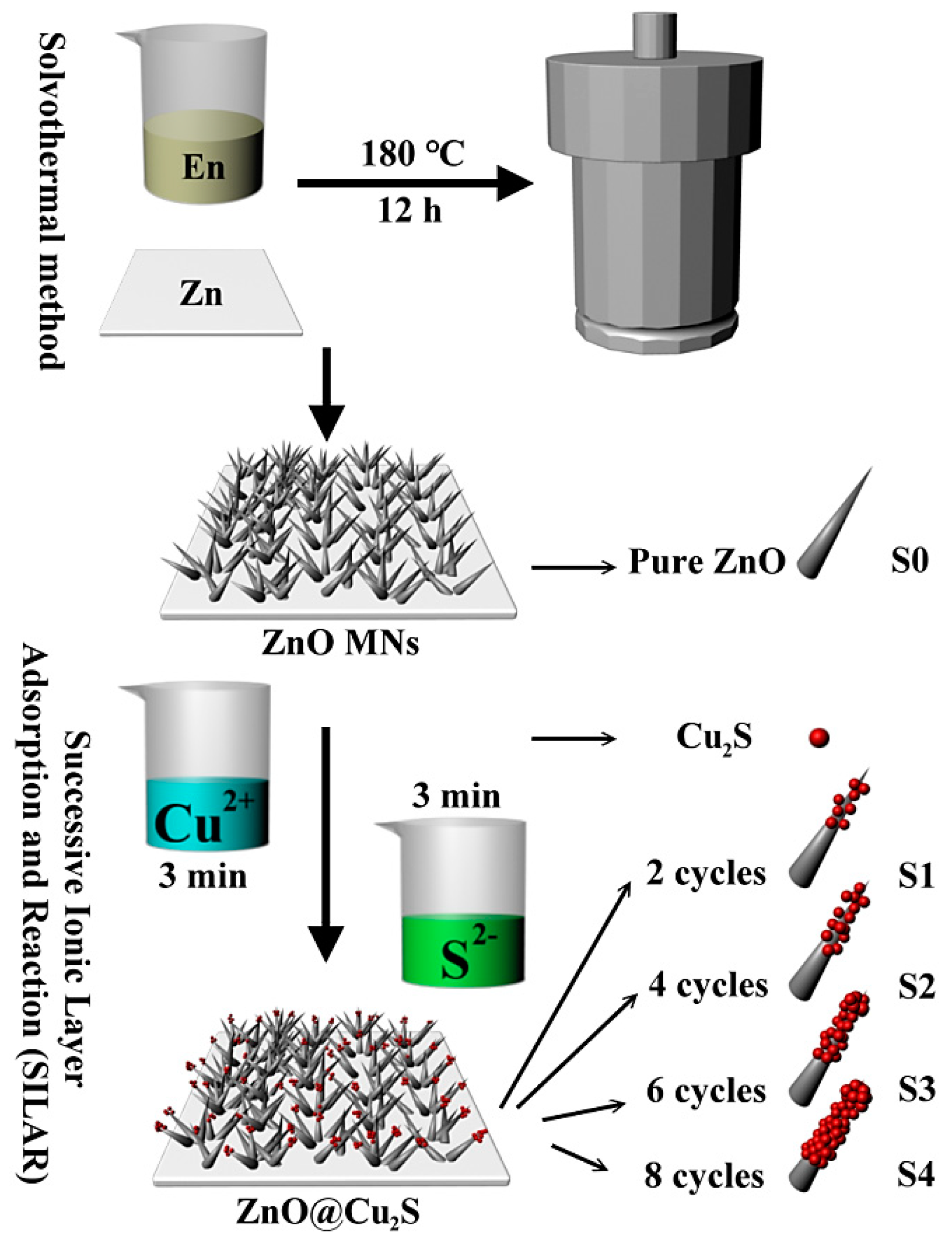
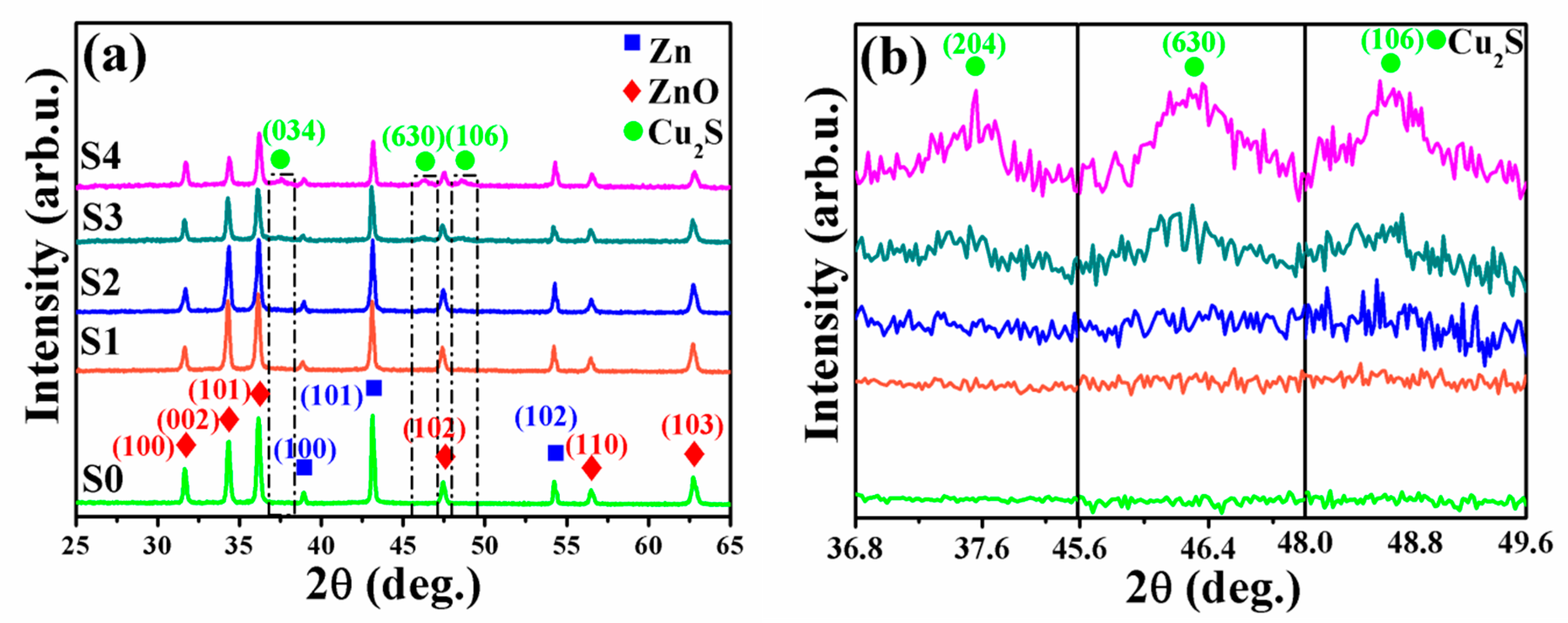
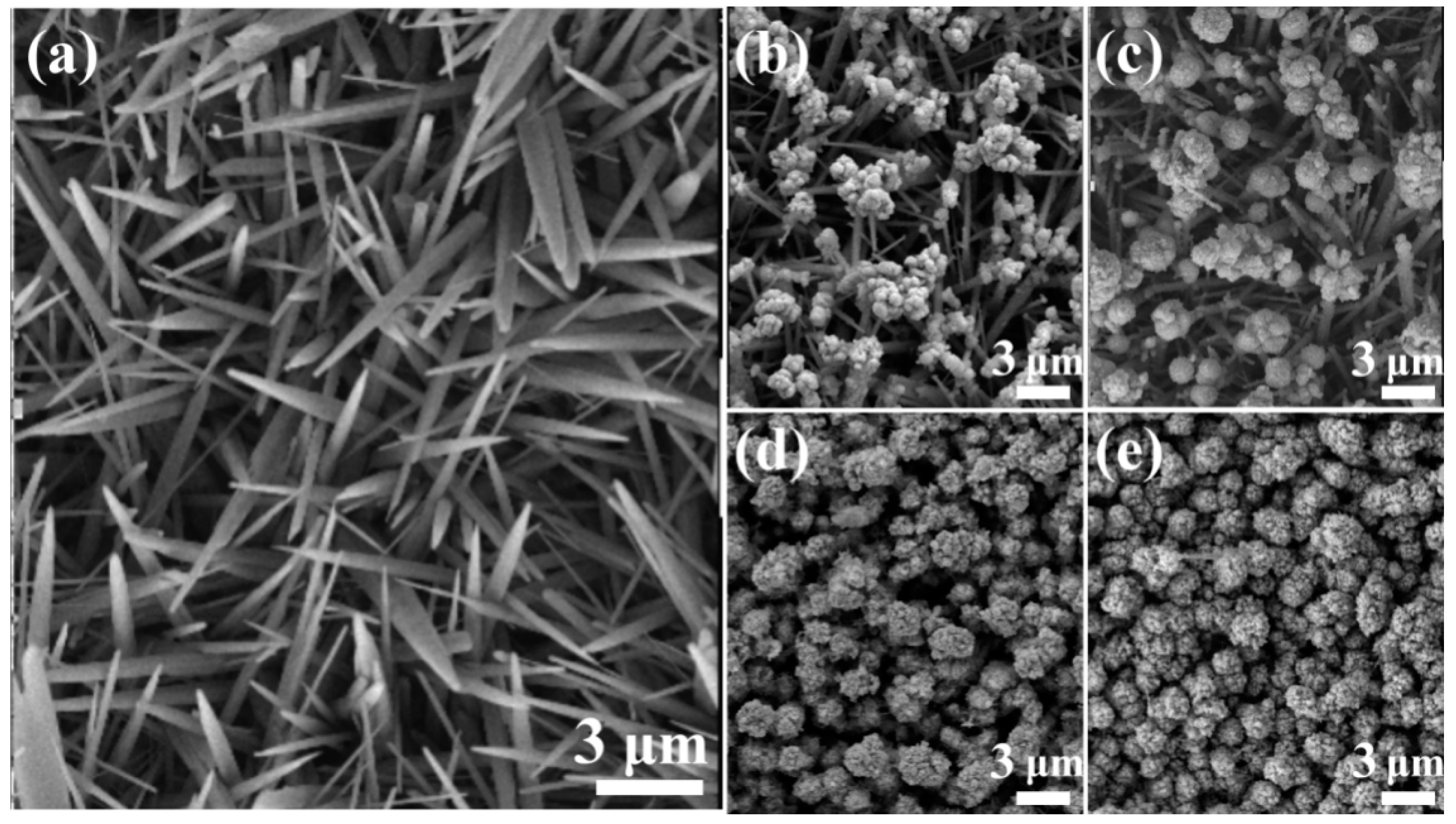
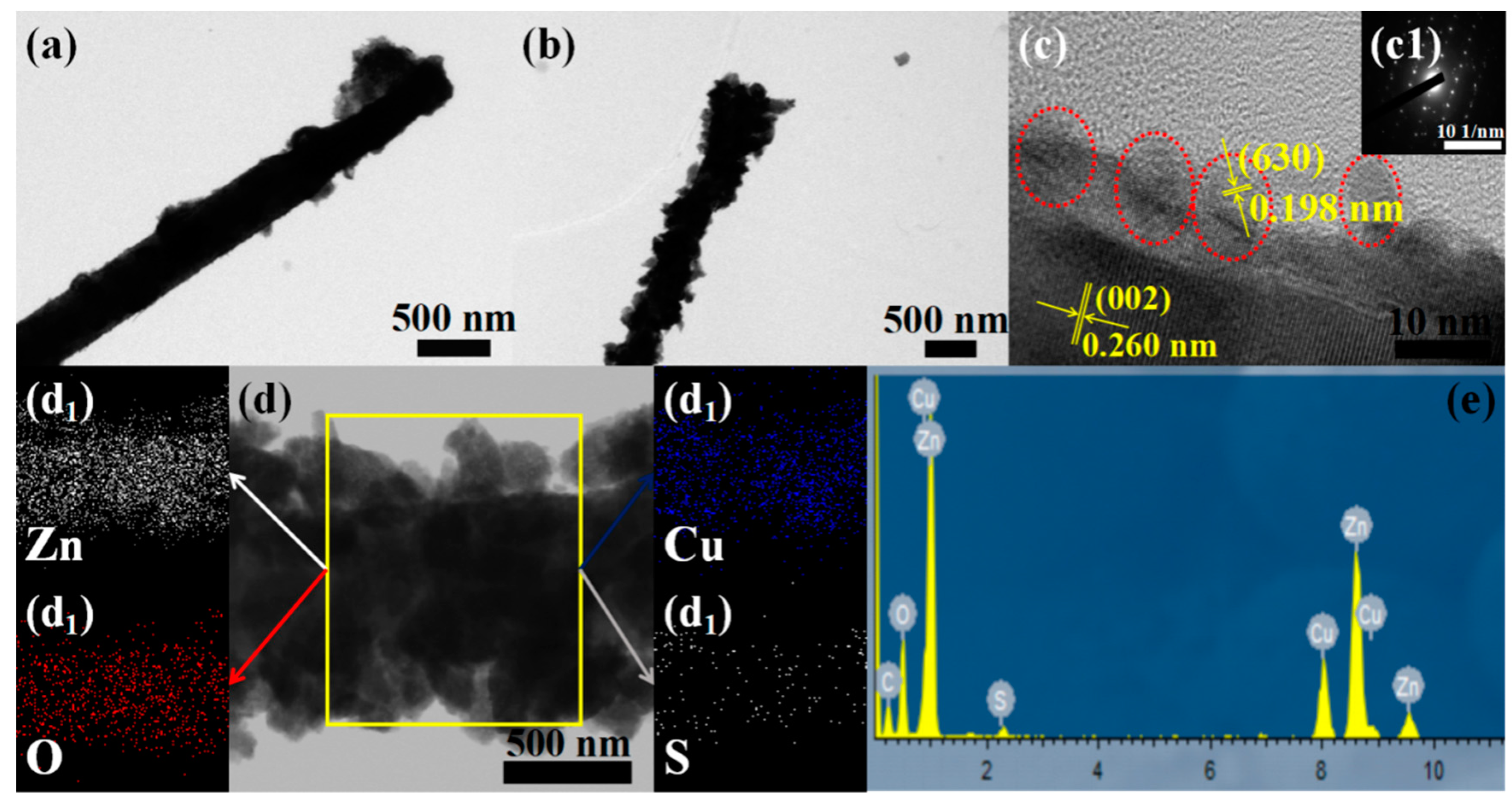
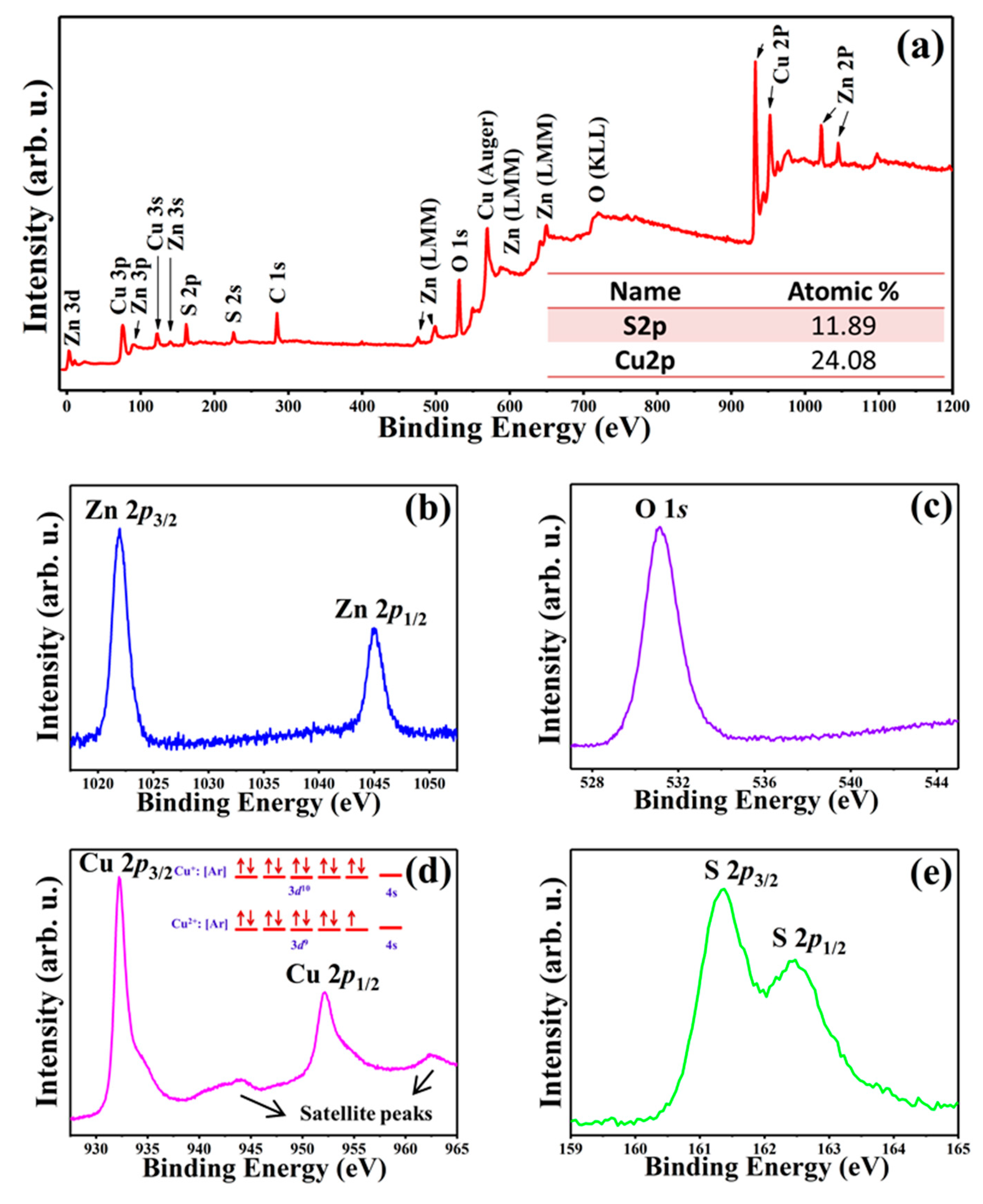
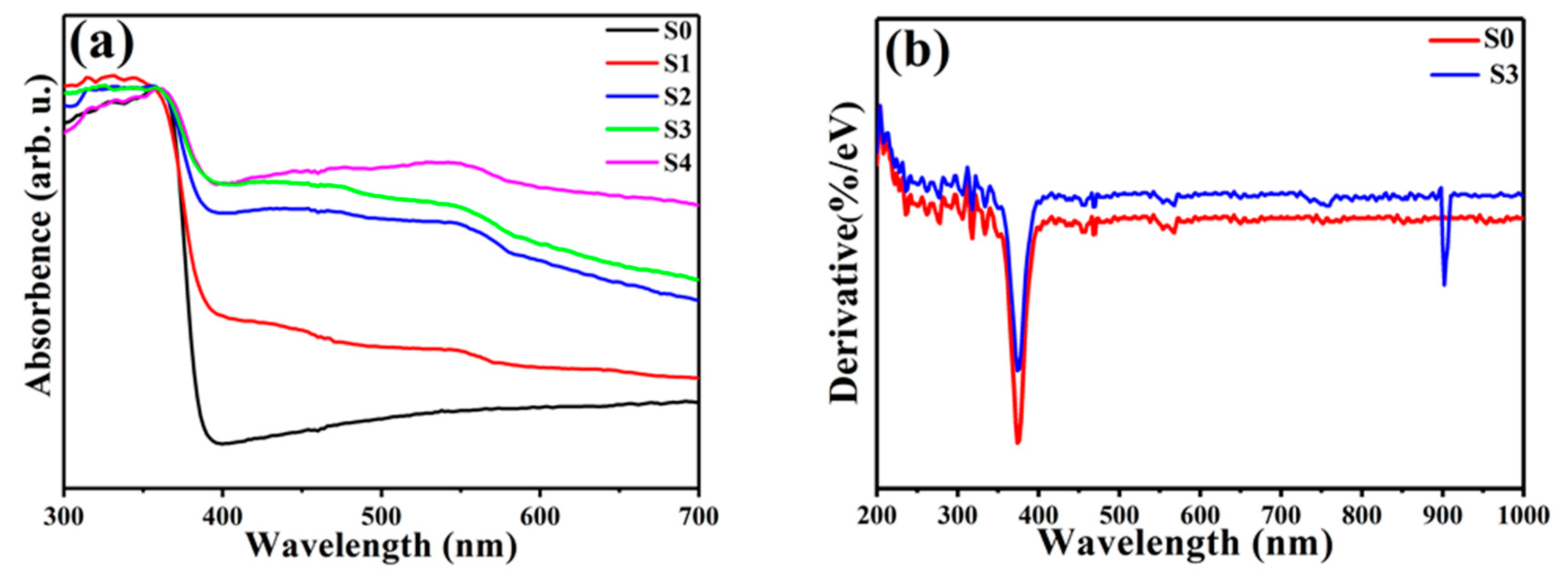

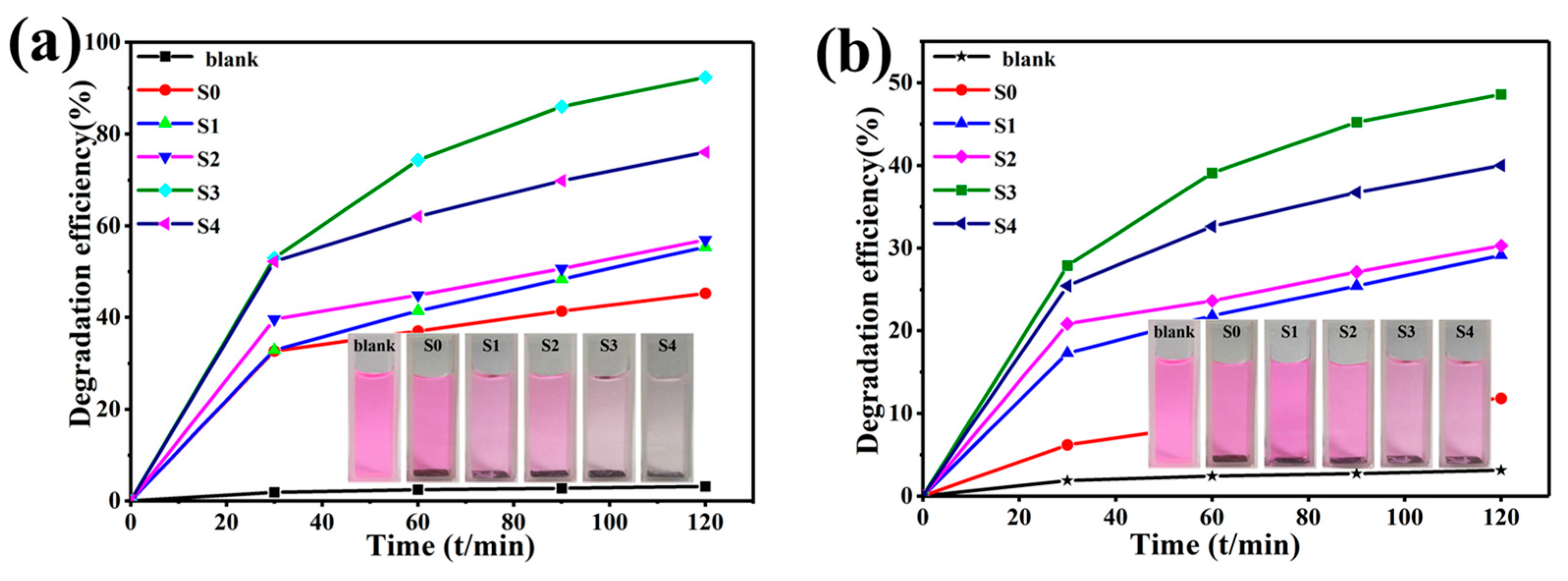
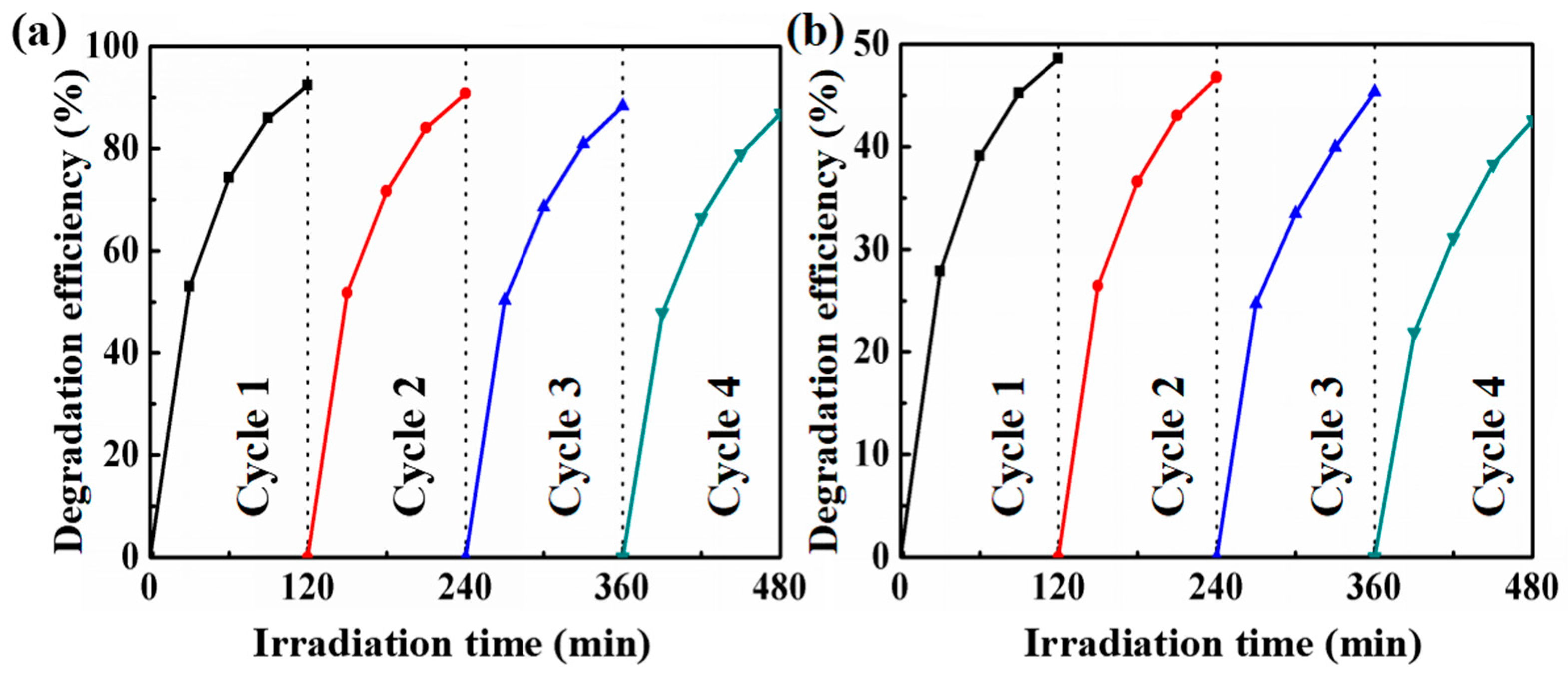
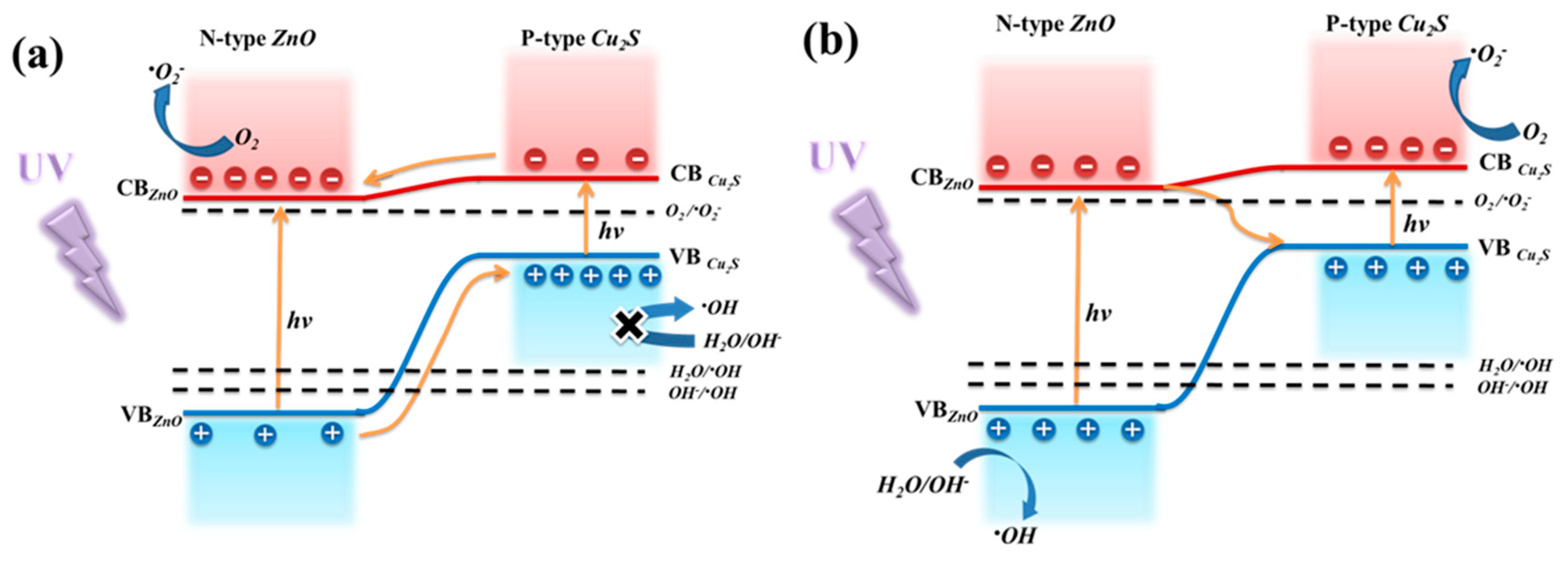
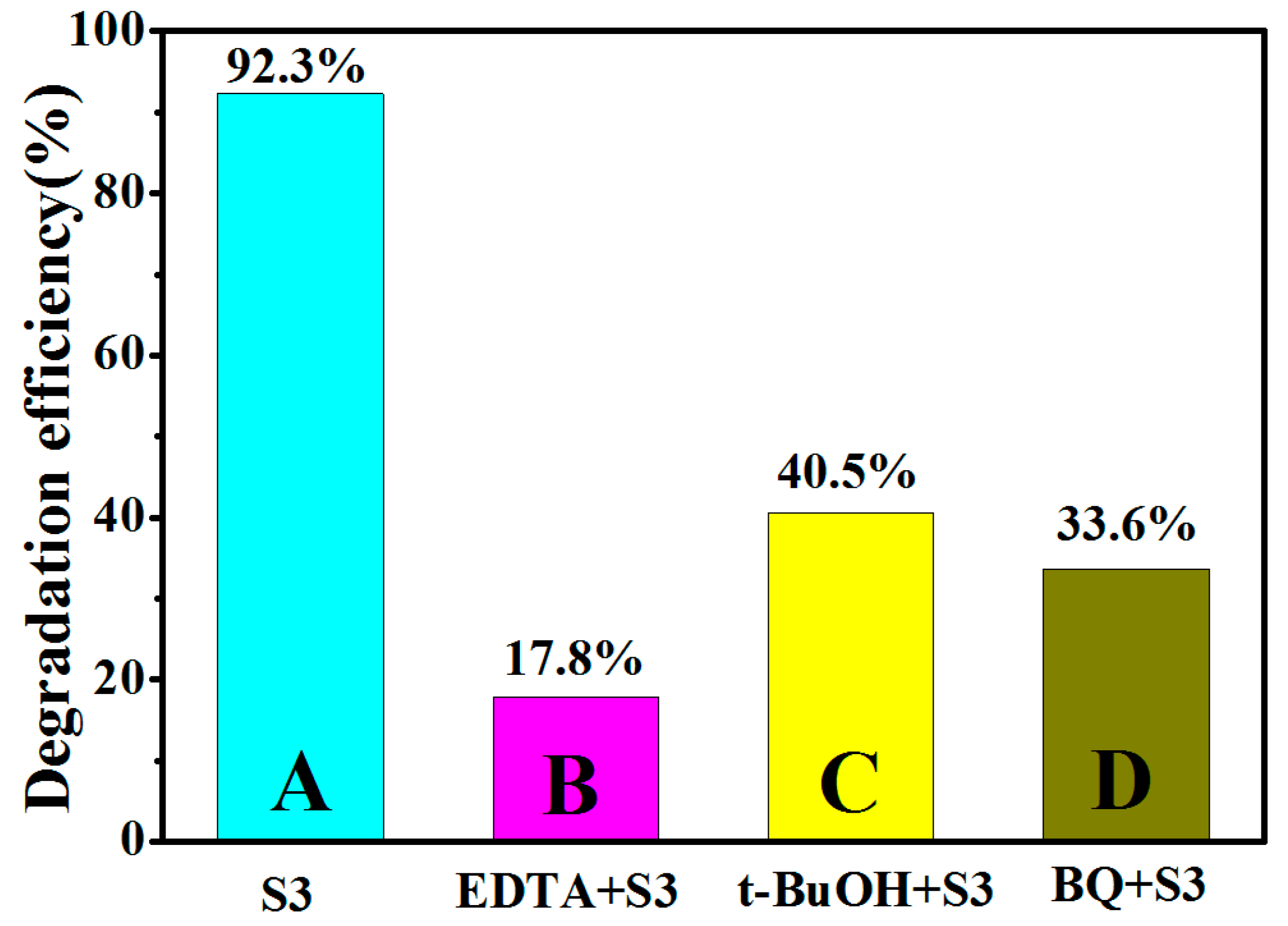
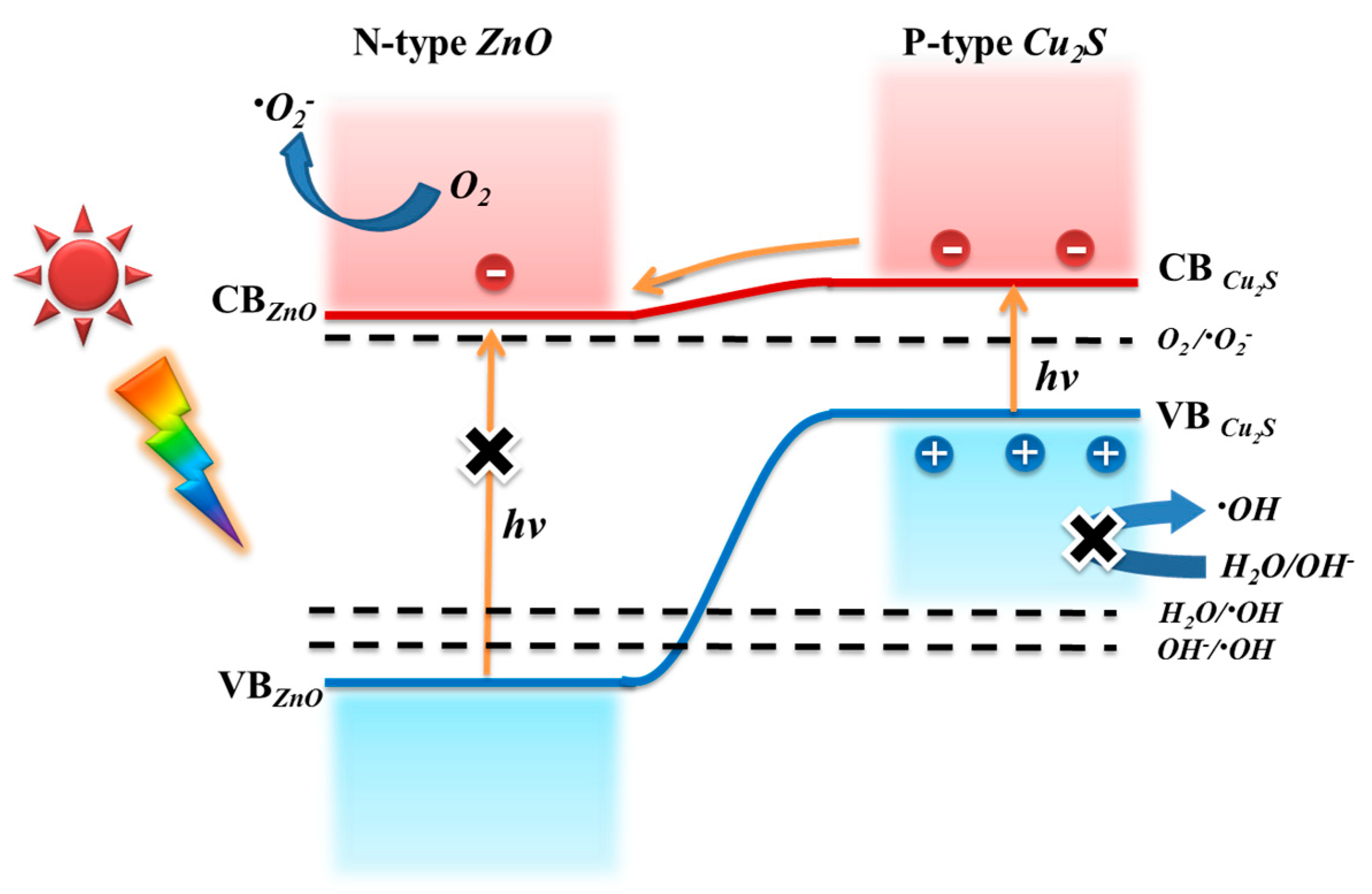
| Sample | Amount | Application | Concentration & Usage | Power Source | Time | Efficiency | Ref. |
|---|---|---|---|---|---|---|---|
| Ag3PO4/ZnO heterojunction | 20 mg | Rh B degradation | 10 mg/L 50 mL | Xe lamp 125 mW/cm2 | 15 min | 100% | Luo et al. [105] |
| Ag3PO4/ZnO heterojunction | 50 mg | Rh B degradation | 9.0×10−6 M, 25 mL | Xe lamp 500 W | 40 min | 96% | Liu et al. [106] |
| ZnO/CuO composites | - | MB degradation | 10 ppm | halogen lamp 500 W | 92.5% | Harish et al. [107] | |
| ZnO/CuO heterostructure | 2 × 2 cm2 | Rh B degradation | 1.0 × 10−5 M, 40 mL | Mercury lamp 500 W | 400 min | 100% | Pal et al. [108] |
| ZnO@AgI hierarchical | 50 mg | MO degradation | 10 mg·L−1 50 mL | metal halide lamp 70 W | 90 min | 83.1% | Huang et al. [109] |
| AgI/ZnO heterojunction | 15 mg | Rh B degradation | 1.0 × 10−5 M, 50 mL | Xe lamp 500 W | 150 min | 100% | Wang et al. [110] |
| TiO2/g-C3N4 heterojunction | 40 mg | MB degradation | 6.0 × 10−5 M, 80 mL | LED light 30 W | 100 min | 100% | Li et al. [111] |
| MoS2@Cu2S heterojunction | 2.5 mg | MO degradation | 6.0 × 10−5 M, 20 mL | Xe lamp 300 W | 60 min | 95% | Zhang et al. [112] |
| ZnO/Cu2S/ZnO complex film | 2.5 × 2.5 cm2 | MO degradation | 1.0 × 10−4 M, 30 mL | Mercury lamp 175 W | 90 min | 86% | Wang et al. [113] |
| ZnO/Cu2S/ZnO complex film | 2.5 × 2.5 cm2 | MO degradation | 1.0 × 10−4 M, 20 mL | Mercury lamp 175 W | 90 min | 75% | Xu et al. [114] |
| ZnO/CdS heterojunction | 50 mg | Rh B degradation | 5.0 × 10−5 M, 100 mL | Xe lamp 300 W | 90 min | 100% | Li et al. [115] |
| ZnO/SnO2 nanocomposites | 40 mg | MB degradation | 6.0 × 10−5 M, 100 mL | Mercury lamp 250 W | 80 min | 100% | Lin et al. [116] |
| WO3/g-C3N4 heterojunction | 100 mg | MB degradation | 3.0 × 10−5 M, 100 mL | Xe lamp 300 W | 120 min | 97% | Huang et al. [117] |
| Ag2CrO4-GO composites | 20 mg | Phenol degradation | 5.0 × 10−5 M, 100 mL | Xe lamp 300 W | 60 min | 90% | Xu et al. [118] |
| Cu2O/ZnO Hetero -nanobrush | - | MO degradation | 1.0 × 10−5 M | solar simulator 100 mW/cm2 | 120 min | 93% | Deo et al. [31] |
© 2018 by the authors. Licensee MDPI, Basel, Switzerland. This article is an open access article distributed under the terms and conditions of the Creative Commons Attribution (CC BY) license (http://creativecommons.org/licenses/by/4.0/).
Share and Cite
Han, D.; Li, B.; Yang, S.; Wang, X.; Gao, W.; Si, Z.; Zuo, Q.; Li, Y.; Li, Y.; Duan, Q.; et al. Engineering Charge Transfer Characteristics in Hierarchical Cu2S QDs @ ZnO Nanoneedles with p–n Heterojunctions: Towards Highly Efficient and Recyclable Photocatalysts. Nanomaterials 2019, 9, 16. https://doi.org/10.3390/nano9010016
Han D, Li B, Yang S, Wang X, Gao W, Si Z, Zuo Q, Li Y, Li Y, Duan Q, et al. Engineering Charge Transfer Characteristics in Hierarchical Cu2S QDs @ ZnO Nanoneedles with p–n Heterojunctions: Towards Highly Efficient and Recyclable Photocatalysts. Nanomaterials. 2019; 9(1):16. https://doi.org/10.3390/nano9010016
Chicago/Turabian StyleHan, Donglai, Boxun Li, Shuo Yang, Xinying Wang, Wei Gao, Zhenjun Si, Qinghui Zuo, Yanhui Li, Yanwei Li, Qian Duan, and et al. 2019. "Engineering Charge Transfer Characteristics in Hierarchical Cu2S QDs @ ZnO Nanoneedles with p–n Heterojunctions: Towards Highly Efficient and Recyclable Photocatalysts" Nanomaterials 9, no. 1: 16. https://doi.org/10.3390/nano9010016
APA StyleHan, D., Li, B., Yang, S., Wang, X., Gao, W., Si, Z., Zuo, Q., Li, Y., Li, Y., Duan, Q., & Wang, D. (2019). Engineering Charge Transfer Characteristics in Hierarchical Cu2S QDs @ ZnO Nanoneedles with p–n Heterojunctions: Towards Highly Efficient and Recyclable Photocatalysts. Nanomaterials, 9(1), 16. https://doi.org/10.3390/nano9010016




